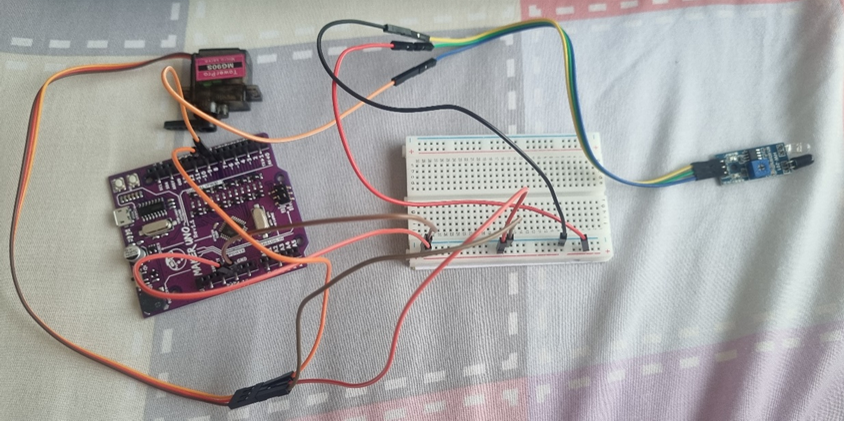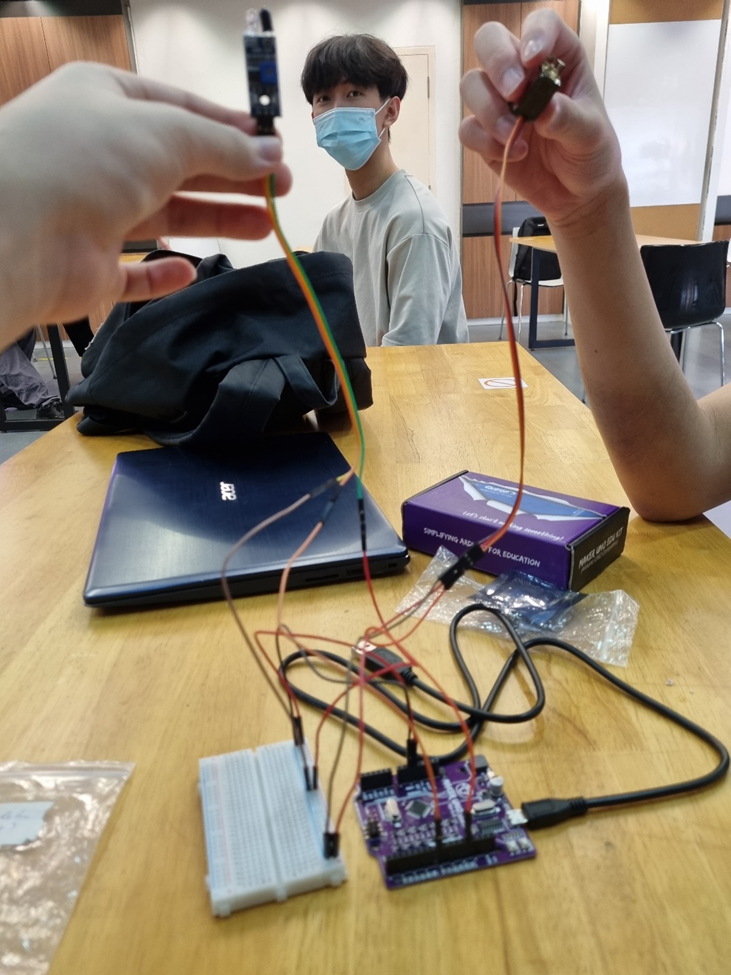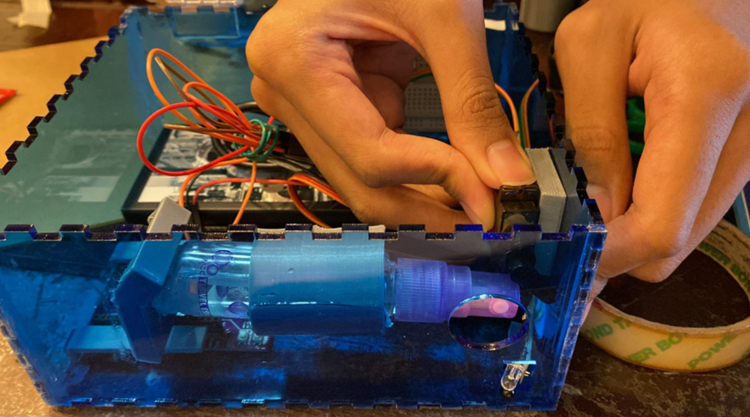Project Development
Project Development Entry
1.
Our team Chemical
Device
In this section,
you will briefly describe your team chemical device.
What it is. What
problems will the chemical device solve? And provide a hand sketch of the
chemical device.
Our chemical device is a door handle sanitizer. It aims to reduce the problem of high
infection rates of Covid-19 through indirect contact by an infected person.
This can be through everyday objects that have been contaminated such as the
door handle. Its function is to detect the hand on the door handle and spray
hand sanitizer onto the door handle after a person lets go of the door handle. By
doing so, it kills any bacteria or viruses on the door handle which in turns
reduces the risk and reduces the rate of Covid-19 infections through indirect
contact.
2.
Team Planning, allocation,
and execution
In this section,
list down your team member's name.
Wei Xue (Team leader)
Firmanshah (Chief Financial Officer)
Anthony (Chief Operating Officer)
Lionel (Chief Security Officer)
Rufus (Chief Financial Officer)
Show the finalized BOM (BILL OF MATERIALS) table.
|
Project Title: |
Automated Door sanitiser |
||||||
|
|
|
||||||
|
Team members: |
Anthony, Wei Xue, Firmanshah, Rufus, Lionel |
||||||
|
Created by: |
Anthony, Wei Xue, Firmanshah, Rufus, Lionel |
||||||
|
Date created: |
16/12/2021 |
||||||
|
BILL OF MATERIALS (BOM) |
|||||||
|
No |
Description of item |
Supplier |
quantity |
quantity unit |
unit price |
Total Cost |
Available at W319 Lab or
FabLab? (Y/N) |
|
1 |
Infrared sensor Module |
1 |
- |
$0.68 |
$0.68 |
N |
|
|
2 |
Maker UNO Edu Kit |
https://robot-r-us.com.sg/p/maker-uno-edu-kit-arduino-compatible |
1 |
- |
$18.70 |
$18.70 |
Y |
|
4 |
Clear Acrylic Sheet | A3 Size (297mm x 420mm x 3mm) |
1 |
374.22 cm3 |
$7.90 |
$7.90 |
Y |
|
|
5 |
Spray Bottle |
1 |
150ml |
$0.64 |
$0.64 |
N |
|
|
6 |
Acrylic Glue |
https://artfriendonline.com/OnlineUsers/Product/PAP_PAD/PAINTING/ACRYLIC |
1 |
50ml |
$3.85 |
$3.85 |
N |
|
7 |
Acrylic Hinges |
https://artfriendonline.com/OnlineUsers/Product/PAP_PAD/PAINTING/ACRYLIC |
1 |
- |
$3.90 |
$3.90 |
N |
|
Grand Total Cost: |
$35.67 |
|
|||||
Show the finalized Gantt chart (planned and actual) and the task allocation for each team member.
Planned:
Actual:
Programming and Setup of Arduino Circuit: Wei Xue and
Lionel
Design of Box: Anthony
Design of Components in box: Everyone
3D Printing and Laser Cutting of Box and Components: Firman, Rufus
3.
Design and Build
Process
In this section,
provide documentation of the design and build process.
Part 1. Design
and Build of Part A (done by Firmanshah).
Part 2. Design and Building of spray holder v2 (done by rufus)
Part 3. Design and Build of the Arduino holder and box (done by Anthony).
Part 4. Coding of
Arduino and Circuit Setup (Wei Xue & Lionel).
1.
talk about Arduino code
idea and main concept.
So, for our main concept of our Arduino Code, we wanted to work like
this: When the IR sensor detects a hand, it will wait for the to move out of
the way, before sending a signal to the servo to press down on the spray
bottle.
2.
talk about finding
something similar to our main concept
We tried
searching up similar projects to base our code around and we managed to find
another door handle sanitizer project.
3.
show how we tweak the
code and final code
This is the code
that he used:
#include <Servo.h>
Servo myservo;
int pos;
int Signal = 8;
int LastState = LOW;
int SensorState;
void setup()
{
pinMode(Signal, INPUT);
//Sensor set as digital input
myservo.attach(9);
//Server set as output
}
void loop()
{
SensorState = digitalRead(Signal);
delay(1);
if
(SensorState != LastState) //if it changed and it's high
{
if
(SensorState == HIGH)
{
Spray();
//Sanitize the door handle
}
}
LastState = SensorStat;
//save current sensor input value for next
comparison
}
void Spray() //spray operation function
{
delay(200);
for
(;pos >= 40; pos -= 1)
{
myservo.write(pos);
delay(15);
}
for
(;pos <= 80; pos += 1)
{
myservo.write(pos);
delay(5);
}
}
//end program
So, based on his
code, the Arduino board will check the state of the IR sensor. If its in the
high state (a hand is detected), a signal is sent to the Servo Motor to run the
Spray function, which is defined at the bottom lines of the code. The Spray
function includes the delay for the hand to move away before the Servo Motor is
in motion. The spray function basically makes the servo motor swing the servo
arm to press down on the spray bottle and return to its original position.
We wanted the
servo arm to have larger a range of motion, therefore, we changed the start and
stop angles of our servo arm, and also the time taken for the servo arm to perform
each action.
Attached below is
our final revised code in the google drive link:
https://drive.google.com/drive/folders/1IoNjm2DpI6_LEMhrlyfs-UZPBVXQFM2x?usp=sharing
talk about
Arduino Setup (wiring, IR sensor and Servo pins)
For our Arduino
Setup,
IR Sensor: pin 8
Servo motor: pin
13
Voltage wires
would all be attached to a breadboard.
Arduino board
will be secured in place by the 3D printed Arduino holders.
4.
show the proposed setups
and limitations due to space available in box.
This is the final
setup that we had come up with, the IR sensor in the left hand and the Servo
Motor in the right. The servo motor would be attached to a surface above the Spray
Bottle, while the IR sensor would be positioned above the door handle. However,
this set-up would look a lot different to the one in this picture due to the
limited space available in the box, and also the cable management that would
have to be done.
5.
(Problem Category: IR
sensor was broken, we thought code was not working, tried on TinkerCAD, substituted
the IR sensor for a button and servo moved == code was working, IR sensor was
the problem)
Part 5:
Assembling the Prototype (Everyone)
During our
assembly of prototype, it was a group effort conducted by all. On 11th
February, we met up in school to build our device.
So this is our
planning stage where we determined where each part would be in the device.
Next, we assembled
the acrylic casing using acrylic glue.
After gluing the
acrylic case together, we started to assemble the interior pieces of the device
using super glue and double-sided tape.
Next, we attached
the acrylic hinge onto the casing so that we can open and close our device.
Afterwards, we
attached our wires, Servo motor and infrared sensor into the case.
Lastly after the
glue is dried, we place our spray bottle in and tested our device.
4. Problems and
solutions
In this section describe the problems encountered in the design and build process and how the team solved them.
Problem 1: When we were
using our first bottle holder design, we realized that if we were to put the bottle into the holder and secure
it into the container, we realized that we were not able to remove the bottle from the side.
Solution: Our solution was
to cut the bottle holder that Firman made into a semi-circle to allow users to
replace the spray bottle as and when it was empty. This would allow us to
replace the bottle from the top instead of the sides.
Problem 2: Servo motor was
not strong enough to push down the spray bottle.
Solution: We decided to cut
the spring inside the spray bottle to lower the spray bottle resistance.
Another solution we did was to increase the range of the servo motor from 40-80
degrees to 30-120 degrees to give it more power to press down the spray bottle.
5.
Project Design Files
as downloadable files
In this section,
provide all the design files (Fusion360 files, .dxf files, .stl files, Arduino
programs files) as downloadable files. You upload these files in OneDrive or
google drive of your personal account. Each person must have these files. Always
check that the links to download the files are working.
Link to edit:
https://drive.google.com/drive/folders/1IoNjm2DpI6_LEMhrlyfs-UZPBVXQFM2x?usp=sharing
Final Prototype

















Comments
Post a Comment